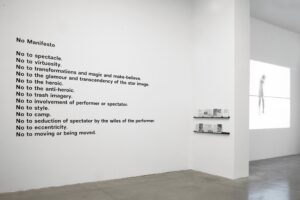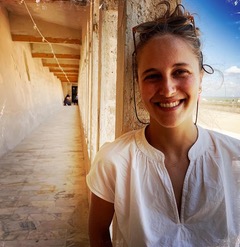“Even dance sometimes gives me moments of pure pleasure, but it doesn’t necessarily come from escaping, from running away from home to immerse myself in the darkness of a theatre, in a world far from yours, from ours. On the contrary, contemporary artists who investigate corporeity often raise questions that are surprisingly close to our daily lives”[1]. It seems that Ada d’Adamo’s words act as an ideal access key to the world of Yvonne Rainer, American choreographer, dancer and film director, of whom the MAMbo in Bologna is currently hosting the first retrospective ever held in Italy.

Yvonne Rainer, Trio A, 1978, Yvonne Rainer: Words, Dances, Films, courtesy MAMbo – Museo d’Arte Moderna di Bologna
The exhibition – curated by Caterina Molteni – opens symbolically with the video-performance Trio A (1978): immediately linked to the poetics of minimalist art, Rainer’s choreography aims to accentuate the difficulty of the single muscular movement, stripping the classic dance of its virtuosity and its dramaturgical plot. What emerges on the surface is a sort of choreographic writing: it is as if by attending her performances, we were led to read the words or, if you prefer, the bone tissue of the dance itself. Hence the evidence of movement as well as stasis, which are equally important. This unmasking allows the arise of a sense of the ridiculous, the one that ultimately invests the “banal” movements of our daily life. Finally, the above-mentioned perception also mixes with a sense of control: far from being mechanical, Rainer’s daily dance is calm, anti-heroic, relaxed and cognitive. Observing her dancing within the space, it would almost seem to be spying on her movements and to be introduced to the vision of something true everyday: what one would tend to make hidden and which, however, underlies an essence of truth.

Yvonne Rainer, Hand Movie, 1966, Yvonne Rainer: Words, Dances, Films, installation view, courtesy MAMbo – Museo d’Arte Moderna di Bologna, 2023, ph. Rmphotostudio
The body is a true treasure of knowledge: it learns and reveals. It embodies. Archive of past experiences and warehouse of encounters, it is the absolute protagonist of Yvonne Rainer’s art. It descends from the heroic stage of theatrical deeds to return to the world which it is originally from. Thus, we see it expressed in details in some experimental videos from the 1960s displayed in the exhibition, such as Hand Movie (1966) or Volleyball (Foot Film) from 1967.

Yvonne Rainer, Volleyball (Foot Film), 1967, Rhode Island Red, 1968, Yvonne Rainer: Words, Dances, Films, installation view, courtesy MAMbo – Museo d’Arte moderna di Bologna, 2023, ph. Rmphotostudio
The spectator is also invested by this bath of reality – always on the edge between voyeurism and humor: the body is offered to the eyes of those who observe. Thus, Rainer broke the barrier between actors and audience and began to see the theater as an environment in which two groups of people actually meet and look at each other. Dance descended from its stage just as minimalist sculpture descended from its pedestals during those same years. Rainer therefore theorizes a new type of spectator whom she asks to watch and participate (a protest aimed at the world addicted to the hyperbolic consumption of products and images that occurred between the 1950s and 1960s): the body of the performer – plus a person like the other than a star – exists in its anatomical physicality, as well as a body among other bodies that are watching it. It exists twice.

Yvonne Rainer, Film About a Woman Who…, 1974, Yvonne Rainer: Words, Dances, Films, courtesy MAMbo – Museo d’Arte moderna di Bologna
In the early seventies, Rainer begins to work with the camera, which she will not abandon for at least twenty years. Lives of Performers (1972) is her first and emblematic film that tells the story of a love triangle underpinning moralistic thoughts and clichés regarding the role of women. The alternation between images and off-screen voices conveys the contradictory link between reality and appearances. Thus the need – politically declined to the feminine – not to want to be observed in a fixed and definitive form emerges. This incorporeality of a character – iridescent, ductile and rarely nestable – refers to an entirely intrinsic contradiction of the art of dance: none can be more concrete and ephemeral at the same time. A performance is consumed visually in the present and Rainer resorts to cinema to stop the dance: as she herself declares in Rainer Variations (2002), the cinematic language is powerful enough to be able to interact with the image and speak of social conflicts. Dance and cinema therefore become political.

Yvonne Rainer, No Manifesto, 1965, Yvonne Rainer: Words, Dances, Films, installation view, courtesy MAMbo – Museo d’Arte moderna di Bologna, 2023, ph. Rmphotostudio
The crisis of a love affair and the heavy weight of patriarchal power over women also return in Film About a Woman Who… (1974): the continuity of the film medium acts as a buttress to the broken movements of the lovers’ bodies which move to the rhythms of pauses cadenced. As in Journeys from Berlin (1971-1980), here too a powerful psychoanalytic introspection stands out, rendered by the absence of melodramatic tones and by the sincerity of the cold off-screen voice. In short, at the basis of her cinema as well as her dance there is a strong need to understand the Self. It is no coincidence that her work has also extended to the world of words: we keep in mind the presentation of her No Manifesto in 1965, but above all her poetic production. Together with the corpus of works set up in the Sala delle Ciminiere space, the Bologna retrospective presents the idea of an archive-space in which the visitor – following the immersive use of the films – can access for a more in-depth study of this multifaceted artist.
Daria Ortolani
[1] Ada d’Adamo, Come d’aria, Elliot, 2023, p. 53
Info:
Yvonne Rainer: Words, Dances, Films
30/06/2023 – 10/09/2023
MAMbo – Museo d’Arte Moderna di Bologna
Via Don Minzoni 14 – Bologna
http://www.mambo-bologna.org/mostre/mostra-349/

Graduated in medieval art history at the Bologna Alma Mater Studiorum, she collaborates with the magazine by writing about contemporary art, with a careful eye on sculpture and photography.






NO COMMENT